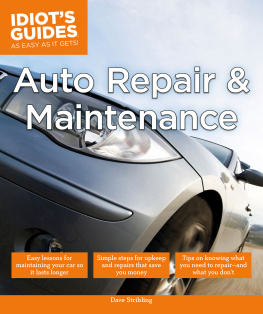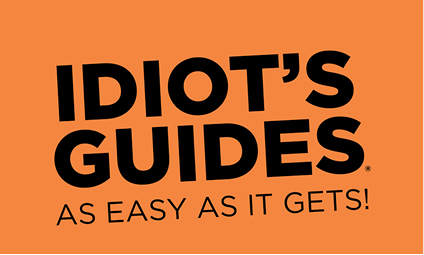Contents
Guide
Auto Repair &
Maintenance
by Dave Stribling
A member of Penguin Group (USA) Inc.
Publisher: Mike Sanders
Associate Publisher: Billy Fields
Senior Acquisitions Editor: Brook Farling
Development Editor: Ann Barton
Design Supervisor: William Thomas
Production Editor: Jan Lynn
Indexer: Johnna Dinse
Proofreader: Claudia Bell
PRODUCTION, LONDON
Digital Producer: Alex Valizadeh
Senior Digital Producer: Miguel Cunha
DIGITAL OPERATIONS, DELHI
Head of Digital Operations: Manjari Hooda
Producer: Rahul Kumar
Assistant Editor: Etika Kapil
DTP Designer: Manish Bhatt
Operations Assistant: Tauhid Nasir
Introduction
My car is doing something weird. What would cause that?
That question, in a nutshell, is why I decided to write this book. As an owner of a business that deals with automobiles, I am constantly getting some form of that question from family, friends, and customers. Sometimes it is a difficult question that requires me to retreat to my library in search of answers, and sometimes it is common knowledge that everyone who owns a car should know.
When I began researching this book, I looked at what was already out there. So many books try to educate you to the point where you can describe exactly what is happening in a four-cycle engine. I think that is missing the point. You probably arent looking for that much information; you just want to know why the car is making that funny rattle. Often the expert wants to share his or her entire knowledge base with you, and all you want to know is if you need to get that thing checked out. I dont typically respond to the above question with a full explanation of how the engine operates. Instead, I usually ask a follow-up question or two and then give you a few things to check. What you find will determine whether you can fix it yourself or if it is time to take it to a professional.
The other problem that arose in writing this book was the fact that automobiles are changing and becoming more sophisticated every year. What was common knowledge a few years ago is now ancient history, so keeping this book relevant was a challenge.
To this end, I decided to write this book as if I were answering your direct question about what is going on with your vehicle. Ill start by answering questions that will most likely pop up while you own your car. Ive asked other experts about what they want you to know about your car when you bring it to them, and what you can do to prevent problems from arising. I wont cover everything that may happen, but I will touch on the most common problems. Ill give you some tips along the way on things you can do yourself, and how to stretch the life of an older car if youre on a budget.
The aim is that youll keep this book to use with your future vehicles. If your friend whos good with cars isnt available, youll have somewhere to go to for the answers you need. Or perhaps youre the uncle or parent who gives this book to a new driver who is in need of some basic knowledge about his or her car. Either way, I hope this book serves you as well as your automobile does.
Acknowledgments
First and foremost, thanks goes to my mother, Carole Stribling, for editing my Midwestern mayhem. Thanks to my kids, Caleb Surber, Kayla Surber, Kara Stribling, and Jordan Stribling. To my sister, Marcia Broady, thanks for your belief in me. Thanks to the following individuals who also contributed information and/or their vehicles to write this book: Amy Stribling, Craig Pattee, Don Gould, Frank Frost, Jeff Etter, John Stephenson, Kenzie Warrick, Kim Stribling, Laurie Studebaker, Loraine Williams, Roger Walther, Marsha Sledge, Marti Henderson, Michael Melvin, Randal Starlin, Reed Oliver, Ron Dickerson, Ron Mendenhall, Seth Nichols, Stephen Maxwell, Steve Wright, Todd Fouty, and Wes Shelton.
Chapter 1
THE BASICS
IN THIS CHAPTER
Chapter 2
Be Prepared
IN THIS CHAPTER
Chapter 3
The Engine
IN THIS CHAPTER
Chapter 4
The Drivetrain
IN THIS CHAPTER
Chapter 5
The Fuel System
IN THIS CHAPTER
Chapter 6
The Ignition System
IN THIS CHAPTER
Chapter 7
The Cooling System
IN THIS CHAPTER
Chapter 8
The Air Conditioning System
IN THIS CHAPTER
Chapter 9
The Exhaust System
IN THIS CHAPTER
Chapter 10
The Computer System
IN THIS CHAPTER
Chapter 11
The Electrical System
IN THIS CHAPTER
Chapter 12
The Braking System
IN THIS CHAPTER
Chapter 13
Steering and Suspension
IN THIS CHAPTER
Chapter 14
Tires and Wheels
IN THIS CHAPTER
Chapter 15
The Exterior
IN THIS CHAPTER
What Every Driver Should Know
Theres a lot of information in this book about how to take care of your car, and not all of it will apply to you. But as a car owner and driver, there are some things you need to know and some things you need to have with any vehicle you drive. Here are the things I, your mechanic, your emergency roadside service, your tire dealer, and your friend who is good with cars wants you to know when driving any vehicle. The rest is optional reading.
. Know what to do in an emergency ().
You may have the best roadside service or automatic call-in on the planet, but it takes time for emergency and roadside help to arrive. You need to be able to secure yourself, your passengers, and your vehicle from harm.
. Understand how your safety systems work.
Car manufacturers are always improving the safety of their vehicles by adding features such as automatic braking and warning sounds to alert you if you drift out of your lane or if there is something in your blind spot. These features can be very helpful, but if you arent aware of them or dont know how they work, they can cause panic or confusion when they engage. Familiarize yourself with your cars safety features so you know what to expect.
Its also important to know how passenger restraint systems, like seat belts and airbags, work in your particular car. Height and distance restrictions are very important, especially for children.
. Carry your owners manual.
The owners manual contains a lot of information about your specific vehicle and what to do in emergency situations. Used cars may not always come with an owners manual. If you dont have one, check with your dealer or go online and get one.
. Know how to inspect, maintain, and change your tires ().
Carry a tire pressure gauge and inspect your tires regularly for signs of wear. Maintaining the correct air pressure will save fuel and prevent unnecessary wear. Regular inspections will alert you to any potential problems.
Even if you never have to change your own tire, you should know how to do it correctly and have the necessary equipment in your car. You need to know where your spare is located and how to get it out. The location of the spare may make it challenging to remove, so check to see if you are capable of removing it and changing it yourself. If you buy a used car, make sure the spare is in good condition and be sure you have a jack and jack wrench in the car.
. Know how to check the fluids in your car.
Most people dont check their fluids as frequently as they should. Like checking your tires, checking your fluids can prevent problems down the road.











